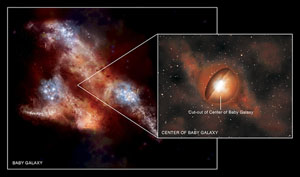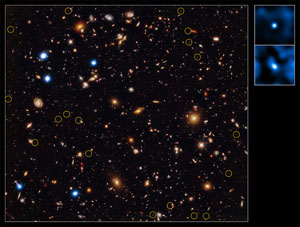X-ray analysis technique developed by Rutgers astrophysicist helps scientists determine that black holes grew voraciously in young galaxies

The finding has important implications for how astronomers understand the early cosmos, according to Eric Gawiser, assistant professor in Rutgers’ Department of Physics and Astronomy, School of Arts and Sciences.
“There is a deep and mysterious connection between galaxies and the supermassive black holes at their centers,” Gawiser said. “They are adding mass at similar rates. We’ve found the first evidence that they grew in lockstep from the absolute beginning.”

The study found that between 30 and 100 percent of the distant galaxies contain growing supermassive black holes. Extrapolating these results from the small observed field to the full sky suggests there are at least 30 million supermassive black holes in the early universe.

“Until now, we had no idea what the black holes in these early galaxies were doing – or if they even existed,” said Ezequiel Treister of the University of Hawaii, lead author of the study that appears in this week’s journal Nature. “Now we know they are there and they are growing like gangbusters.”
Black holes are collections of matter so dense – a million to a billion times the mass of our sun packed into a region smaller than our solar system – that gravity keeps light from escaping. As they draw new matter in, there is intense heating as it collides with existing matter, giving off X-rays, explained Gawiser.

The technique that Gawiser contributed to the research effort is called “stacking,” or adding up all the X-ray counts near the positions of these distant galaxies to find a statistically significant signal. The technique is necessary because each distant galaxy emits only a few X-rays and cannot be individually detected. While astronomers have used stacking techniques for the past decade, Gawiser has developed a method to provide higher statistical confidence in the results. This is the first research study to use Gawiser’s advanced stacking algorithm.
“It appears we’ve found a whole new population of baby black holes,” said study co-author Kevin Schawinski of Yale University. “We think these babies will grow by a factor of about a hundred or a thousand, eventually becoming like the giant black holes we see today almost 13 billion years later.”

The paper’s other authors are Priyamvada Natarajan of Yale University and Marta Volonteri of the University of Michigan. The authors acknowledge support from NASA through Chandra/Einstein Post-doctoral Fellowship Awards, the National Science Foundation, the Smithsonian Astrophysical Observatory and the John Simon Guggenheim Foundation.
Media Contact: Carl Blesch
732-932-7084, ext. 616
E-mail: cblesch@ur.rutgers.edu